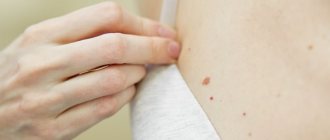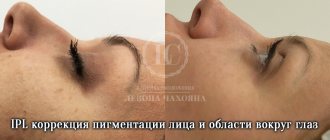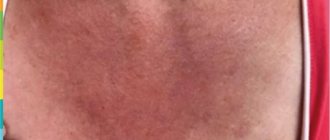During pregnancy, a woman's body undergoes hormonal, physiological and emotional changes. These changes affect all organs and systems, including the skin, because its condition and appearance are directly dependent on the condition and processes that occur in the body as a whole.
Factors influencing changes that occur in the skin during pregnancy:
- initial skin condition
- hormonal status
- features of pregnancy
Even seasonality and changes in diet can affect the condition of the skin during pregnancy.
Why are there pigment spots during pregnancy?
The reason for the appearance of spots is hormonal changes that occur in a woman’s body during pregnancy. Theoretically, after feeding is completed and hormonal levels are restored, pigmentation returns to normal and the spots disappear.
But in practice this does not happen . Pigment cells melanocytes have cellular memory and, despite the absence of increased amounts of hormones, continue to produce excess amounts of melanin locally. The pathological process is aggravated by UV rays , to which melanocytes become especially sensitive.
A study was conducted with the participation of 324 women. The main causes and provoking factors for the development of pigmentation have been identified:
- Ural Federal District
- Pregnancy
- Taking oral contraceptives
- Endocrine disorders
- Genetic predisposition
- Intake or external use of photosensitizers
*often a combination of several factors occurs
The main provocateur of pigmentation, among other disorders, is solar radiation . Under the influence of UV rays, the synthesis of melanocrine is induced - a hormone of the pituitary gland, which activates the work of pigment cells.
Factors that increase the risk of developing pigmentation
The likelihood of pigment spots appearing after childbirth increases due to a number of reasons.
The main ones:
- constant stress that has a bad effect on metabolism;
- lack of vitamins (especially folic acid);
- prolonged exposure to the sun;
- gastrointestinal diseases;
- thyroid diseases.
Heredity plays a big role. The predisposition to pigmentation is transmitted at the genetic level. It is enough to look at photos of mothers and grandmothers to predict the manifestation of postpartum spots in yourself.
How to get rid of age spots after pregnancy
During pregnancy
- Avoid direct sunlight , do not expose to open sun, use caps, hats, sun umbrellas;
- Apply sunscreen with SPF daily . During pregnancy and after, it is preferable to use a mineral SPF based on zinc oxide or titanium dioxide. These products are hypoallergenic, do not penetrate the skin, but lie in an even, imperceptible layer on the surface of the skin, creating a mineral screen from all types of UV rays.
During lactation
- Continue to protect your skin from ultraviolet radiation as during pregnancy
- Start using lightening agents that meet the requirements:
- without irritating and toxic effects
- combined composition of ingredients with different mechanisms of action on pigmentation
- free of retinoids, hydroquinone and acids
You should not wait for the end of feeding and recovery; it is possible and advisable to extinguish the increased activity of melanocytes already in the present moment.
For what reasons does postpartum pigmentation on the face persist?
If you can’t get rid of age spots on your face after childbirth, you need to consult a dermatologist.
The reason for the long-term (longer than a year) persistence of postpartum pigmentation can be a number of internal or external factors. Among them:
- disturbances in hormone synthesis;
- kidney or liver pathologies;
- poor nutrition;
- frequent exposure to the sun;
- fungal invasion;
- oncological neoplasms;
- long-term breastfeeding;
- gastrointestinal diseases;
- gynecological diseases;
- avitaminosis;
- disorders of the thyroid gland.
Only a doctor can identify the exact cause of the defect, based on the results of a laboratory examination. Independent use of any means increases the risk of developing health problems not only for the woman, but also for the newborn.
What products to use during pregnancy and lactation
Mineral cream SPF 30 with zinc DermaQuest based on micronized zinc oxide 18.6%.
Sunscreen for all family members from babies to pregnant mothers!
Advantages:
- Does not penetrate deep into the skin
- Absolutely safe and hypoallergenic
- Broad spectrum skin protection against all types of UV rays: UVA and UVB
- There are no contraindications for use - it can be used by young children and pregnant women
- Blocks up to 97% of sun rays
- In 2022, the composition is enriched with BlueLight filters against blue light
Tone cream SPF30 with zinc for the face DermaQuest - for working mothers, as well as for those who do not like pale skin color.
An analogue of mineral cream with SPF30, which contains pigments that give the skin a light tan.
CBD "Blue Light" face cream SPF 30 DermaQuest - for those mothers who, despite maternity leave, spend a lot of time in front of a computer monitor, tablet or smartphone, as well as for those with sensitive or irritated skin.
This is a complete day cream with protection against the entire spectrum of radiation to get rid of pigmentation and prevent aging!
How does it work:
- Protects skin:
- from dryness and dehydration
- from ultraviolet rays of any intensity
- from oxidative stress
Contains:
• Mineral SPF – zinc oxide – broad-spectrum protection, anti-inflammatory effect;
• Cannabidiol is a plant ingredient with healing, soothing and restorative effects. Ingredient – BOOM2019, used in medicine;
• InfraGard – filter against blue light – prevention of premature aging;
• BV-OSC – active form of vitamin C – antioxidant, normalizes skin color and increases its elasticity;
Application:
Daily in the morning after your regular serum. One application is enough!
DermaQuest SkinBright serum and cream are a combination that enhances each other’s effectiveness.
Advantages:
- Rich composition of safe brightening ingredients
- Does not require additional skin care products
- Moisturize, nourish, have an antioxidant effect
- Prevention of age-related changes
Contains:
- Stem cells of Lily Snow White
- Melanostatin-5 (brightening peptide)
- Chromebright
- Bakuchiol A (Vitimon A simulator without the irritating effects of retinoids)
- Hexylresorcinol – 4 times more active than hydroquinone in lightening effect
- Emblica – plant extract
- Kojic acid dipalmitate
- Bearberry, licorice root and white mulberry extract
- Arbutin
SkinBright preparations do not contain Hydroquinone!
They do not have an irritating effect, have a moisturizing and nourishing effect, making them a complete treatment used morning and evening for the entire face. There is no need for local application and the purchase of additional care products!
Contraindications to the use of anti-pigmentation products
For a young mother, the main thing, while restoring her attractiveness, is not to harm the baby’s health.
Anti-pigmentation agents should not be used:
- until the child is 3 months old;
- if the mother or newborn has a tendency to allergic reactions;
- when there are microdamages, rashes, and areas of inflammation in the treatment area;
- if there are contraindications to the use of a particular cream.
It is prohibited to lighten spots caused by dermatological diseases - such marks will go away on their own after complete recovery.
Chemical peeling
This manipulation has found wide application in modern cosmetology practice. And many doctors, when asked how to remove stains, recommend exposure to chemicals to their patients.
There are three types:
- Superficial is the most gentle form. It will take from 4 to 10 procedures with an interval of 10 days;
- The middle one is a more effective option. The result can be seen after the first procedure. Perform once every 30 days.
- In-depth treatment is allowed only once every 6 months.
Important: in women with hypersensitive skin, blisters and scars appear after the procedure.
General principles of treatment
Often pigmentation appears in a pregnant woman. The reasons are basically the same. In some cases, unsightly cosmetic defects disappear on their own after the birth of the child; nothing needs to be done. To get rid of pigmentation after pregnancy, it is necessary to rely on the reasons that led to their formation.
Treatment depends on the following factors:
Composition and instructions for use of Sebozol shampoo
- If a hormonal imbalance occurs, then you need to visit a gynecologist and get tested for the ratio of hormones. If a specific cause is identified, the doctor will prescribe therapy to restore hormonal balance.
- For problems with the digestive tract, healthy nutrition is recommended, as well as diagnosis of the underlying etiology. The treatment regimen differs significantly in each specific case, as it depends on the underlying disease.
- For nervous disorders, mild sedatives are prescribed. The feasibility of the appointment is determined individually. It should be remembered that when breastfeeding, many medications are strictly forbidden to be taken, since their active ingredients pass into breast milk.
- In case of endocrine disorders, seek help from an endocrinologist. Research depends on the suspicion of a particular disease; accordingly, the treatment algorithm is determined on an individual basis.
If there is a hereditary factor, conservative therapy is not needed. In this case, hardware techniques in beauty salons and specialized products will help get rid of pigmentation after childbirth.
Useful video about pigmentation after childbirth
Pigment spots after childbirth
List of sources:
- Kruglova L. S., Ikonnikova E. V. Skin hyperpigmentation: modern views on etiology and pathogenesis // Scientific article on the specialty “Fundamental Medicine. Russian Journal of Skin and Venereal Diseases. 2017; 20(3): 178-183 p.
- Olisova O. Yu. Andreeva E. V. Once again about the problem of hyperpigmentation // Scientific article in the specialty “Clinical Medicine”. Russian Journal of Skin and Venereal Diseases. 2017; 20(4): 248-251 p.
Author
Elena Medvedeva
Specialist
Share
Home Recipes
It is also possible to remove postpartum pigmentation on the face at home with an integrated approach and a not very severe stage of the disease.
Since you can use essential oils after pregnancy, arm yourself with orange, lemon or some other citrus oil, jojoba or almond oil and clay. Clay can be taken in any color, but black, white and green are the most effective. Take 2 tablespoons of clay, add water to it until it becomes a thin cream, 5-7 drops of base oil, 3-4 drops of essential oil, mix thoroughly and apply to the face. Leave for 10-15 minutes; when it starts to dry out, sprinkle with thermal or regular water.
Using only aspirin tablets (2-3) and water, you can make your own acid peeling, mask or serum, which will be no less effective, but safer - the acid here is salicylic, which is not related to AHA acids.
Also don't forget about lemon juice, which can be mixed in a 1:2 ratio with water and used as a lotion at night.











